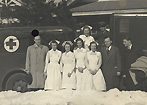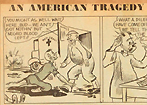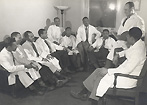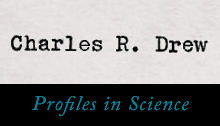Education
Higher Education Modules
Life after Death: Dr. Charles Drew, Civil Rights, and the Legacy of Race
Life after Death: Dr. Charles Drew, Civil Rights, and the Legacy of Race module is divided into three overarching and interrelated units that emphasize (1) the importance of medicine during the Second World War, (2) segregation and racial science, and (3) the importance of historical memory and rumors as truth-telling. The three units are divided into six one-hour long classes, each providing an introduction to the material, primary and secondary sources, discussion questions, and interactive in-class exercises instructors might use while teaching about the life and death of Charles R. Drew. Information about the module's author, suggested use, and academic objectives, is also available online at About the Module.
 Unit 1. Medicine during the Second World War contains materials for two classes on how medicine shaped the military war effort, particularly the ways in which medicine was considered a "battlefront" essential to winning the war. The first class provides a framework for understanding why the endowment of medicine for soldiers and civilians was equated with American success. The second class examines Dr. Drew's refinement of blood banking policies during this important period.
Unit 1. Medicine during the Second World War contains materials for two classes on how medicine shaped the military war effort, particularly the ways in which medicine was considered a "battlefront" essential to winning the war. The first class provides a framework for understanding why the endowment of medicine for soldiers and civilians was equated with American success. The second class examines Dr. Drew's refinement of blood banking policies during this important period.
Class 1: War and Science
Class 2: Father of the Blood Bank
 Unit 2. Segregation and Racial Science analyzes how segregation and scientific racism entered conversations around the Civil Rights Movement and American Red Cross. Class three examines black participation during the Second World War and the ways in which the "Double V" campaign became a galvanizing force for the Civil Rights Movement. The fourth class focuses on the American Red Cross policy of segregating blood donations based on supposed racial differences inherent within blood, highlighting the continuing prevalence of scientific racism on American soil during the war.
Unit 2. Segregation and Racial Science analyzes how segregation and scientific racism entered conversations around the Civil Rights Movement and American Red Cross. Class three examines black participation during the Second World War and the ways in which the "Double V" campaign became a galvanizing force for the Civil Rights Movement. The fourth class focuses on the American Red Cross policy of segregating blood donations based on supposed racial differences inherent within blood, highlighting the continuing prevalence of scientific racism on American soil during the war.
Class 3: The Double Victory Campaign and Black War Participation
Class 4: "Bad Blood" and the Superstition of Science
 Unit 3. Historical Memory situates the life and death of Dr. Charles Drew within a historical framework of rumors and memory. Historical analysis is not only about what we think we can prove through traditional archival resources, but also how historical experiences shape the lens through which people understand the past. The fifth class situates Dr. Drew's narrative within a broader framework of race, health, and memory shaped in part by the well known Tuskegee Syphilis Study. The final class introduces Dr. Drew's life after death and the persistent rumors of his being denied medical treatment that continue to shape his memory. Truth takes on many different forms and rumors can persist because of how they speak to historical experiential truths.
Unit 3. Historical Memory situates the life and death of Dr. Charles Drew within a historical framework of rumors and memory. Historical analysis is not only about what we think we can prove through traditional archival resources, but also how historical experiences shape the lens through which people understand the past. The fifth class situates Dr. Drew's narrative within a broader framework of race, health, and memory shaped in part by the well known Tuskegee Syphilis Study. The final class introduces Dr. Drew's life after death and the persistent rumors of his being denied medical treatment that continue to shape his memory. Truth takes on many different forms and rumors can persist because of how they speak to historical experiential truths.
Class 5: Race, Memory, and Health
Class 6: Life after Death for Dr. Charles Drew


